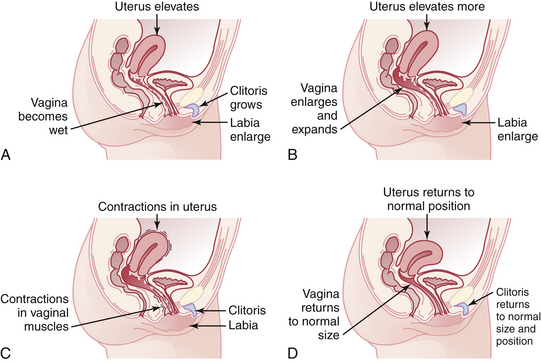Chapter 27 Sexuality and Female Sexual Dysfunction
 Variation in Sexual Expression
Variation in Sexual Expression
Transgender or transsexual individuals are often confused with homosexuals. They have a strong belief from childhood that they were born into a body with the wrong sex. Most are heterosexual to their identified gender (i.e., men who believe they are women are attracted to men), and few are homosexual. Children with ambiguous genitalia who are assigned a particular gender may later show regret toward their assignment. Some experts recommend that these children be given a name that is appropriate to both genders to allow them to decide their gender for themselves later in life. Female-to-male transsexuals (FTM) are women that grow up as “tomboys” and often cross-dress. Male-to-female transsexuals (MTF) are men that grow up dressing as women. Transgender surgery is difficult to perform, especially FTM, and it is only performed in certain areas of the United States and the world. Box 27-1 lists some other variations in human sexual expression along with their definitions.
BOX 27-1 Other Forms of Sexual Expression and Their Definitions
 Sexual Response
Sexual Response
FEMALE SEXUAL RESPONSE CYCLE
The Excitement Phase
This phase starts with physical or psychological stimulation and may last minutes or hours. There is a sex flush, accompanied by erection of the nipples and engorgement of the breasts. A sex flush is an erythematous morbilliform skin change over the chest, neck, and face that occurs to a noticeable degree in 75% of women. In addition, the uterus elevates, and vaginal lubrication begins. The clitoris and labia enlarge, and the heart rate and blood pressure increase. Most muscles become tense (Figure 27-1A).
The Plateau Phase
During this phase, the breasts continue to enlarge, and the clitoris may elevate and retract under its hood. The Bartholin’s glands may secrete fluid near the vaginal opening, and there is tenting of the uterus to allow easier passage of sperm. The vagina and labia become more engorged, and there is increased blood pressure, heart rate, respiratory rate, and muscle tension (see Figure 27-1B).
 Sexual Development
Sexual Development



